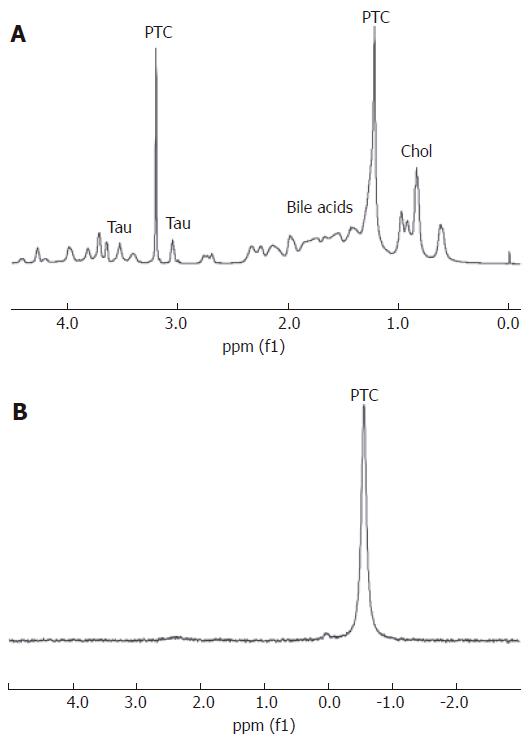Copyright
©2006 Baishideng Publishing Group Co.
World J Gastroenterol. Aug 14, 2006; 12(30): 4773-4783
Published online Aug 14, 2006. doi: 10.3748/wjg.v12.i30.4773
Published online Aug 14, 2006. doi: 10.3748/wjg.v12.i30.4773
Figure 5 A: 1H nuclear magnetic resonance spectrum of bile collected at laparoscopic cholecystectomy, after a history of recurrent cholecystitis.
The spectrum has no contamination from contrast agents. The major peaks are assigned to phosphatidylcholine (PTC), bile acids, cholesterol (Chol), taurine (Tau) and the reference, sodium trimethylsilyl-[2H4] propionate (TSP); B: Corresponding 31P nuclear magnetic resonance spectrum. The major peak is assigned to PTC. ppm, Parts per million. Reproduced from Khan SA, Cox IJ, Thillainayagam AV, Bansi DS, Thomas HC, Taylor-Robinson SD. Proton and phosphorus-31 nuclear magnetic resonance spectroscopy of human bile in hepatopancreaticobiliary cancer. Eur J Gastroenterol Hepatol 2005; 17: 733-738, with permission from Lippincott Williams & Wilkins, Inc.
- Citation: Cox IJ, Sharif A, Cobbold JF, Thomas HC, Taylor-Robinson SD. Current and future applications of in vitro magnetic resonance spectroscopy in hepatobiliary disease. World J Gastroenterol 2006; 12(30): 4773-4783
- URL: https://www.wjgnet.com/1007-9327/full/v12/i30/4773.htm
- DOI: https://dx.doi.org/10.3748/wjg.v12.i30.4773









